Water News for July 2012
While you were celebrating Garden Hose Day and trying on you new school clothes, a lot of important things happened in the interesting world of water. Read on to hear all about it.
Pharmaceuticals and personal care products in US drinking water
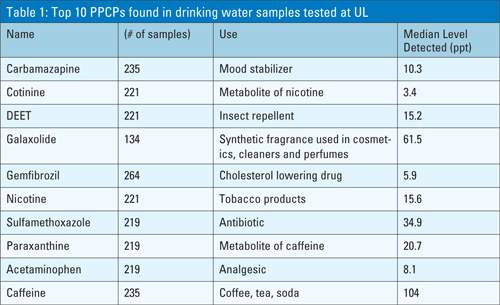 |
The chart shows the top ten pharmaceuticals and other personal use products (PPCPs) found in the drinking water of American cities in a large Associated Press study.
"AP's investigation determined that a wide array of pharmaceuticals, including antibiotics, anti-convulsant drugs and mood stabilizers, were found in the drinking water supplies that serve at least 41 million Americans. Specifically, pharmaceuticals were found in the drinking water supplies of 24 major U.S. metropolitan areas. The AP investigation also tested samples from the watersheds of 35 of the 62 major providers and found pharmaceutical concentrations in 28 of those watersheds."
Read the full article (including how to remove PPCPs from water) in the Pure Water Gazette.
|
The U.S. Geological Survey Has Found Ancient Groundwater Under Maryland
Some of the water under Maryland is older than a million years, the first such ancient groundwater found along the Atlantic Coast, the U.S. Geological Survey reports. There are relatively few aquifers in the world in which million-year-old groundwater has been documented These include the Nubian aquifer in the Sahara Desert, Canada’s Alberta Basin, and the Great Artesian Basin in Australia. The ancient water under Maryland resides in the Patapsco aquifer.
The Maryland aquifer provides freshwater for the region east of Washington and Baltimore. Modern-day pumping rates have lowered water pressures and changed water chemistry, affecting the aquifer’s ability to provide freshwater for drinking and other uses. Concerns over saltwater intrusion in some areas have led water managers to increasingly move groundwater production from shallower aquifers to the deeper upper Patapsco aquifer, which has caused groundwater levels to decline.
The USGS has a “groundwater watch” database containing records from about 850,000 U.S. wells over the past 100 years.
More from USA Today
Water Department Employees Fail to Fluoridate Water
Two Gilbert AZ water department employees were placed on leave while the town investigates why the North Water Treatment Plant failed for the past 13 months to put fluoride in the water. A town spokeswoman said the water is safe to drink, but that the failure to fluoridate the water is unacceptable.
Two Die in Louisiana After Infection by the Amoeba Naegleria fowleri: Amoeba Infection Is Usually From Sinus Irrigation with Tap Water
The amoeba Naegleria fowleri (N. fowleri), which has a 99 percent fatality rate, was found in water samples taken from the homes of two people from Louisiana who died in August 2012 from primary amebic meningoencephalitis (PAM) – an almost universally fatal infection – after using neti pots filled with tap water to irrigate their sinuses.
Water samples taken from the victims’ homes tested positive for Naegleria fowleri (N. fowleri), a climate-sensitive amoeba found in warm freshwater lakes and rivers. N. fowleri has over a 99 percent fatality rate, with only one known survivor in the U.S. since 1962.
The amoeba enters the body through the nose and migrates through the olfactory nerve to the brain. Symptoms, which occur one to seven days after exposure, include headache, fever, stiff neck, loss of appetite, vomiting, confusion, seizures, coma and death.
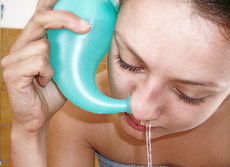 |
| Neti Pot |
Here are some facts.
Although the condition is almost always fatal, it is also very rare. There are less than ten cases per year in the US. Some years there are none. The highest number of cases, 8, were reported in 1980.
The condition is not associated with general water use like drinking, bathing or showering. It seems to be associated mainly with water directly forced up the nose during sinus irrigation.
N. fowleri is normally a warm-weather amoeba found primarily in Southern states, but it seems to be moving north, probably because of climate change.
In most cases, city distribution systems do not test positive for N. fowleri, but rather, the home's plumbing. How the amoeba enters the home's piping system is unknown, but once in the pipes the organisms are able to survive and spread through the hot water system.
More on the Gazette's website.
Cholesterol, Chlorine, and Chickens
by Gene Franks
When Pure Water Products started making garden hose filters a few years ago, our thought was that we were making a product for organic gardeners who wanted to spare their tomato plants a chlorine bath. We quickly learned, however, that water filters fitted to garden hoses are also useful to people who want to rinse off their patio without leaving hard-water spots, wash their car, fill their child's wading pool, put clean water into a bird bath, change the water in an aquarium, provide good tasting water for work crews, give horses clean drinking water, sprinkle the front lawn with chlorine-free water, fill a coy pond or a hot tub, or wash their windows.
We had provided water for dogs, horses, cats, song birds, and fish, but it was only recently that we learned of the garden hose filter's utility as a clean water source for backyard chickens.
Our customer Jerry Samouce sent us pictures of his backyard chicken ranch where his birds enjoy the luxury of carbon filtered rainwater. Here's the way it works:
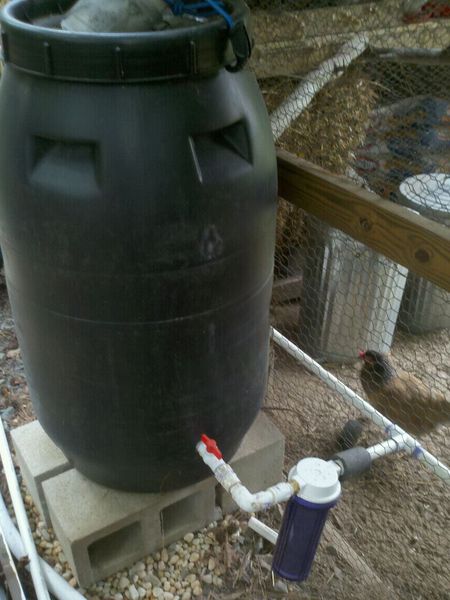 |
Jerry's gravity-driven watering system uses a converted 50-gallon pickle barrel as a holding tank. Rainwater is collected from the roof of the coop and stored in the tank. Pushed by gravity, it goes through the adapted garden hose carbon block filter on its way to the chickens. |
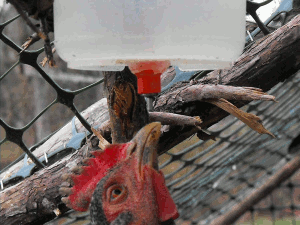 |
The water is dispensed to the chicken via simple but effective devices called chicken nipples. |
To my knowledge not a lot of research has been done to determine what constitutes healthful water for happy chickens. The large-scale commercial chicken and egg industries, of course, have spent tons of money on additives to water designed to promote freakishly abnormal body growth and hen-destroying egg production. Their aim, of course, is not the health of the individual chicken but their own bottom line, and a healthy chicken is defined as one who grows fast or drops lots of eggs, not one who lives a long time, doesn't have nightmares or develop osteoporosis. With factory chicken farmers, longevity and contentment aren't an issue.
The well being of chickens wasn't the aim of one fairly large research project that involved the effects of chlorine on chicken health, but it definitely should be something that backyard chicken keepers consider. (If you doubt that backyard chicken ranchers have the best interests of their birds at heart, please read some of the backyard chicken keeper blogs. Chickens with names, whose owners record their daily activities and pictures in blogs and newsletters, are more than mere food providers.)
The research project I'm talking about is that of Dr. Joseph Price. Back in the late 1960s, Dr. Price put forth a very plausible alternative to the cholesterol theory of the origins of heart disease in his interesting little book called Coronaries/Cholesterol/Chlorine. Dr. Price argued convincingly that heart disease was virtually unknown before the 20th century, although high-cholesterol food consumption certainly wasn’t. What was new in the 20th century, he pointed out, and what seems to parallel exactly the onset of heart problems as a major disease, is the practice of disinfecting public water supplies with chlorine.
To test his theory, Dr. Price did a pretty extensive experiment with chickens and seemed to prove that chickens who eat a diet containing oleo and lots of chlorine quickly develop heart problems, while chickens eating oleo without the chlorine don’t. The numbers were convincing, with 95% of the oleo/chlorine group of chickens developing arteriosclerosis fairly quickly. Price himself cautioned that no conclusion should be generalized to humans from animal research. But the theory and some of the evidence he presents are strong. Although an EPA scientist replicated some of his research and basically endorsed his findings, Price was totally ignored by the medical community, which is notoriously uninterested in any idea that doesn't support its own current dogma.
The implication for backyard chicken raisers is that it's a good idea to put a touch of chlorine into your water tank to keep things fresh, but it's also a good idea to use a carbon filter at the tank's output to protect your chickens from the chlorine and keep the water fresh and good-tasting.
For more on this and the work of another cholesterol heretic, see Hardly Waite's "Dr. Batman Thumbs His Nose at "Bad Cholesterol." For more on chlorine and heart disease, see Dr. Martin Fox, "Chlorination: A Link Between Heart Disease and Cancer."
There are step-by-step details for building Jerry Samouce's chicken watering device at www.backyardchickens.com. Thanks to Jerry for letting us use his picture.
 |
Tar Sands Mining Is a Sticky Issue in Water-Poor Utah
Bitumen, a black sticky substance that native Americans used to call “rocks that burn,” is now commonly called tar sands oil. In Utah there is a lot of it. Enough, it is estimated, that if it is mined for oil extraction it could supply US energy needs for three full years. That’s 25 billion barrels of oil.
U.S. Oil Sands, a Canadian company, has leased about 32,000 acres in Utah for tar sands mining. Environmental groups, especially Utah-based Living Rivers, oppose the project. More details. |
Bacteria In Tap Water Can Be Traced to the Water Treatment Process
Editor’s Note: An interesting article from ENews Park Forest brings up topics that are long overdue for discussion regarding the nature of microbes in water and their relationship to water treatment devices. It may be that an irrational fear of microbes has lead us to overreact and adopt water treatment strategies of questionable merit. Bacteria-free water should not be confused with healthful water. Bacteria are everywhere. When we take a short-sighted “kill ‘em all” position, we run the risk of killing ourselves. –Hardly Waite, Gazette Senior Editor.
Most of the bacteria that remain in drinking water when it gets to the tap can be traced to filters used in the water treatment process rather than to the aquifers or rivers where it originated, University of Michigan researchers discovered.
Their study—a unique, broad-based look at Ann Arbor’s water supply from source to tap—could open the door to more sustainable water treatment processes that use fewer chemicals and, as a result, produce lower levels of by-products that may pose health risks. Eventually, the work could enable engineers to control the types of microbes in drinking water to improve human health like “live and active cultures” in yogurt, the researchers say.
Please go here for the rest of the article.
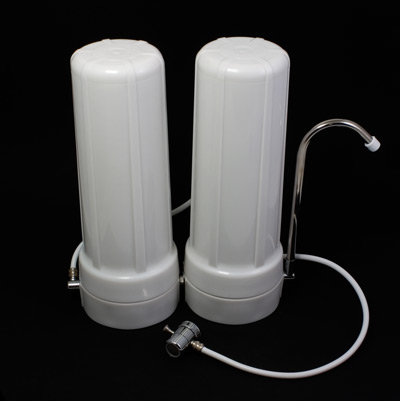 |
Classy Pure Water Products Double Countertop. Double Countertops offer twice the filtration capacity as well as greatly increased treatment options. We stock dozens of cartridges that will fit this filter. You can design your own system by the selection of cartridges. More information. |
Water News of the Month
Here are a month's worth of water stories from the Pure Water Gazette's "Today's Top Water News" feature. Some are referenced in this issue, but there are a lot more to look at.
 |
How Aeration Systems for Iron and Hydrogen Sulfide Work
by Pure Water Annie
Air Is Cheap and It Does Not Create By-Products.
Talk Is Also Cheap, but It Does Not Oxidize Fe or H2S.
|
A typical pump-driven aeration system is pictured below.
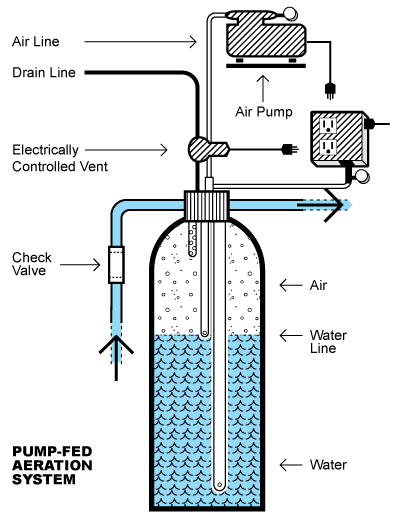 |
| A Classic Compressed Air Treatment System. To Treat Iron and Hydrogen Sulfide, a Filter Must Follow this Unit. |
Aeration is used in water treatment as a pretreatment in the process of removing iron and hydrogen sulfide (rotten egg smell) from water. Air is a powerful oxidizer of both iron and hydrogen sulfide. It quickly converts unfilterable ferrous iron to filterable ferric iron, and it reduces hydrogen sulfide to elemental sulphur, which is easily removed from water by a filter.
Air is a very fast oxidizer--considerably faster than chlorine.
The illustration above of a typical residential aeration system shows one of the ways that air can be introduced into water to treat iron and hydrogen sulfide. It features a small air compressor and a special tank in which treatment takes place. The system above has an electrically controlled vent system to release some of the hydrogen sulfide gas to the atmosphere, but especially to provide for a turnover of air in the tank.
The air pump delivers air into the tank and a pocket of compressed air forms in roughly the top third of the tank. As water enters the tank through the pipe at left, it hits a baffle (of the three pipes attached to the vent head, it's the short pipe on the left) and sprays down through the pocket of compressed air. The water is further aerated inside the tank before it leaves by way of the long tube (called a riser) which picks it up at the bottom of the tank and sends it out through the pipe at right. The mid-length tube in the center is the vent tube. It controls the depth of the air pocket.
When the air pump is activated, the solenoid valve opens at the same time and an air/water mixture exits the tank via the middle tube and the drain line.
The pump and vent are controlled by the same electrical circuit so that when the pump is running, the vent is open and air is being exchanged. When the pump turns off, the vent closes and the compressed air pocket is maintained.
The electrical circuit that turns the pump/vent system off and on can be controlled in a variety of ways. The most common is by wiring them into the well's own pump circuit, so that the aeration system is activated when the well pump is running. Another way--and this is shown in the diagram--is with a specially designed control that monitors the pressure inside the aeration tank and activates the pump/vent according to aeration tank pressure. A third popular activation system is a flow switch, which turns the pump/vent system on when water is flowing to the home. The simplest air pump control is a simple lamp timer, which is used to activate the pump and solenoid at intervals, assuring a good turnover of air and a fresh air pocket in the tank.
More information.
 |
Numerical Wizard B. Bea Sharper ferrets out the watery facts that Harper's misses
|
Facts You Would Have Learned from This Issue Had You Been Paying Attention
Percentage of chickens who got heart disease from a high oleo/chlorine diet in Dr. Joseph Price's experiments--95%.
Estimated years that US energy needs could be met by tar sands oil in Utah, if developed--3.
Rank of the insect repellant DEET among the top ten PPCPs found by the AP study of US waters -- 3.
Gallon capacity of Jerome Samouce's pickle barrel water reservoir -- 50.
Number of months Gilbert AZ citizens were deprived of fluoridated water by errant water dept. employees -- 13.
Average level of nicotine found in the water samples studied in the AP study--15.6 ppt.
Age of the ancient waters of the Patapsco aquifer under Maryland -- 1,000,000 years plus.
Fatality rate of primary amebic meningoencephalitis -- 99%.
Total number of deaths from primary amebic meningoencephalitis for 1980, the highest on record -- 8.
Pure Water Gazette Now in a New Format
Our information-stuffed variety magazine, the Pure Water Gazette, has taken another turn. The Gazette started as a paper publication in the 1980s. The last paper issue was mailed in 1997. It has existed since as an information-rich website whose navigation and aesthetic properties were suffering from years from neglect. Although the old site can still be seen here, the best of the old content has been relocated to a much more manageable and search-friendly blog-style format. The new site is up and running as a work in progress with over 300 articles and many more to come. At least one new article is added each day. The new site is at the old location, http://www.purewatergazette.net. Please visit!
|
